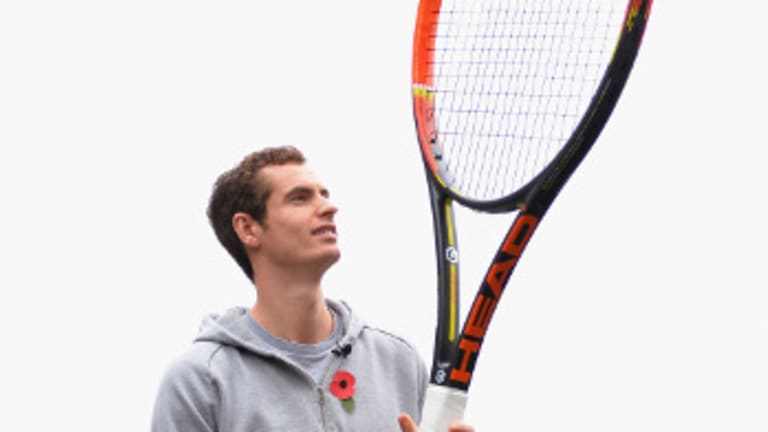LONDON—It is in some ways a cruel irony that, having shed one monkey off his back by winning Wimbledon this summer, Andy Murray has been forced to miss the end of a successful season in order to deal with another, less metaphorical one. A little less than seven weeks ago, Murray had surgery to deal with a chronic lower-back problem and has yet to return to the court, but the British No. 1 was on relaxed form last week, appearing at Queen’s Club to launch HEAD’s new racquet series, the HEAD Graphene Radical.
Graphene, an extremely lightweight nanomaterial, allows for an optimal redistribution of weight to the grip and tip of the racquet, which in turn generates more kinetic energy. I asked Ottmar Barbian, HEAD’s VP and Division Manager for Racquet Sports, for the layman’s version of what that means: "The racquet is lighter. You can swing it faster and if you swing it faster, you can generate more power ... Less effort and more power."
Murray, who has been testing the racquet since Wimbledon, confirmed that when he returns to the court he will be using the HEAD Graphene Radical Pro. I sat down with Murray, in between photo shoots and video interviews, to ask him about his new racquet, his recovery from injury, and his plans for returning to competition. In some ways, he told me, having a clean break from the game—albeit an enforced one—makes changing racquets easier.
"When you’ve been playing a lot, you feel the slightest changes in a ball or court speed or racquet or grip or whatever it is, but when you haven’t been playing for six weeks, your arm almost feels numb," Murray said. "No matter what you’re playing with, it would feel weird anyway."
So he won’t, on his return, be blaming his racquet—in which he’s "only found positive things"—but the timing of that return is still uncertain. He planned to hit some balls—"very few and very light"—this week and is heading to Miami on Monday for his customary training block, although its intensity will depend on how those first few tentative hits go. He is still nominally committed to the Dream Cup exhibition in Barbados at the end of November, but he’s insistent that he won’t return until he’s ready to compete at full speed. In the meantime, he’s doing weights, Pilates, and running in water on "basically an underwater treadmill", which sounds like a rarefied form of torture but apparently spares the back and joints.
"Not being able to hit the balls, though—it’s starting to get to the stage where I want to be able to do that again and I’ve started to miss it," Murray said.
Murray seems so calm about being relegated to the sofa, watching bits of Paris and Basel and unable to compete in the World Tour Finals, that I have to ask him how he’s dealing with what must be an extremely irksome situation.
"I would like to be playing," he admits. "But it wasn’t as frustrating as pulling a hamstring or something that just comes on the court. This is something that’s been going on for a long time and I’ve been playing through pain for too long."
The back problem caused him to miss the French Open this year and has clearly been a nagging physical and psychological sore for longer than we knew.
"I had to take the break, it was a decision I had to make," Murray said. "I’d been playing in pain for 19, 20 months, it was just getting gradually worse and worse...but to actually fix the problem and not have to deal with it hopefully for the next five, six years of my career—I just wanted to get it done."
Despite the loss of continuous competitive honing, of ranking points—and the subsequent seeding implications—there’s an element of control in being able to time the break and surgery which perhaps accounts for Murray’s relaxed and positive demeanor. He is, as he points out, "not going to miss any Grand Slams" by taking this time, and he knows that soon enough, all of his rivals will also be taking time off from the tour.
"I have to look at it like that," he said. "I’m basically just resting my body and getting it back to neutral after a hectic year and some issues."
It can’t hurt to rest the mind, either. It seems so long ago that we watched Murray lift the Wimbledon trophy, a transformative moment which is hard to quantify, but what it must have taken out of him to win the title is perhaps equaled by the time and energy required to adjust to the changed state of affairs. From being regarded with uneasy and uneven affection by his country, Murray is now all but nailed on to win the BBC Sports Personality of the Year award, to the extent that some bookmakers have stopped taking bets. During his competitive hiatus, Murray has also been awarded the Order of the British Empire (OBE) for "services to tennis." He wouldn’t be drawn on whether he would have preferred to receive the honor at the hands of the Queen rather than the Duke of Cambridge, who was hosting his first investiture, but noted that it was "quite cool" to have been among the first to receive an award from the future king.
"Winning on the court is obviously nice but, you know, getting that sort of recognition from the royal family, from the country... it means a lot. It was a nice day," Murray said.
Exactly which services he received the Order for were left unspecified, but HEAD Chairman Johan Eliasch, who described Murray as HEAD’s "finest ambassador for the sport," noted that after Murray won Wimbledon, their sales tripled. That’s a service to tennis, right there.
